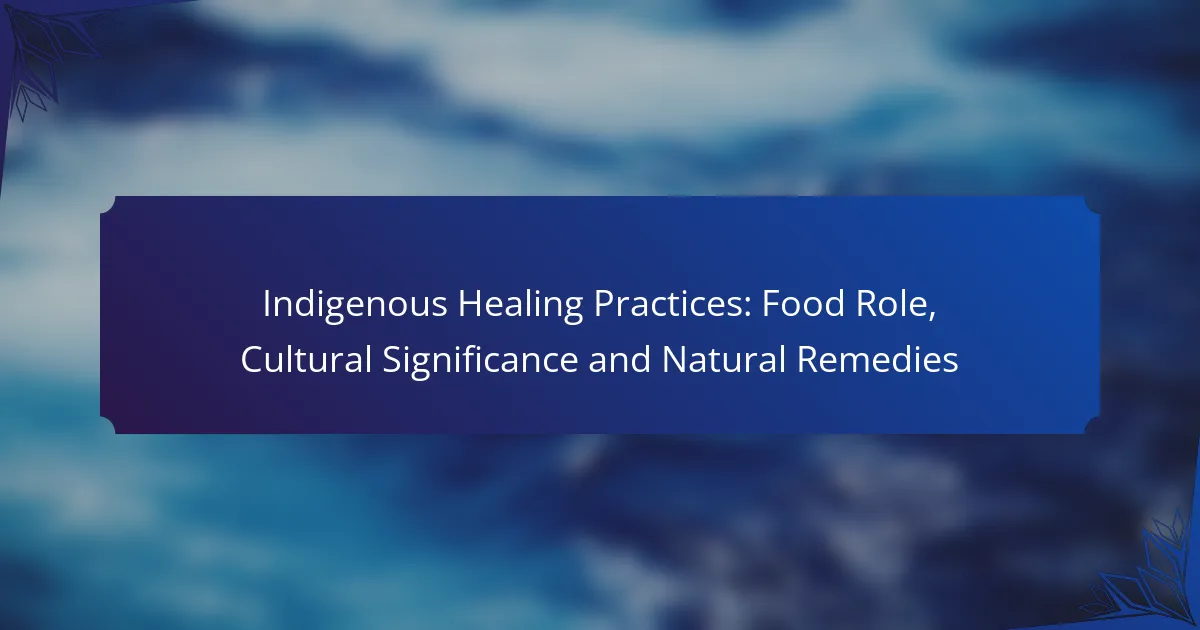Indigenous healing practices are essential for promoting health and well-being, with food playing a crucial role in their holistic approaches. These traditions highlight the nutritional and medicinal significance of traditional foods, reflecting a deep connection to cultural beliefs and the natural environment. By incorporating natural remedies and emphasizing the interconnectedness of body, mind, and spirit, these practices offer a comprehensive understanding of health rooted in community and tradition.

How do Indigenous healing practices utilize food?
Indigenous healing practices often incorporate food as a vital element for promoting health and well-being. These practices emphasize the nutritional, medicinal, and cultural significance of traditional foods, which are integral to holistic healing approaches.
Traditional food sources
Traditional food sources for Indigenous communities typically include locally sourced plants, animals, and fish that are rich in nutrients. Common examples are wild game, berries, nuts, and various herbs that have been used for generations. These foods not only provide sustenance but also play a crucial role in maintaining cultural identity.
Many Indigenous groups have specific seasonal practices for harvesting these foods, ensuring sustainability and respect for the environment. This connection to the land reinforces the importance of traditional ecological knowledge in food sourcing.
Medicinal properties of native plants
Native plants are often recognized for their medicinal properties, which are utilized in various healing practices. For instance, plants like echinacea and sage are commonly used for their anti-inflammatory and antibacterial effects. Indigenous healers often prepare teas, poultices, or tinctures from these plants to treat ailments.
Understanding the specific properties of these plants is essential for effective use. Many Indigenous communities have developed extensive knowledge about which plants can alleviate specific health issues, passed down through oral traditions.
Food as a cultural connector
Food serves as a powerful cultural connector among Indigenous peoples, reinforcing community bonds and shared heritage. Traditional meals are often prepared and consumed during ceremonies, gatherings, and celebrations, highlighting their significance beyond mere nutrition.
Sharing food is a way to transmit cultural values and teachings, fostering a sense of belonging and identity. Engaging in traditional food practices can strengthen community ties and enhance the collective well-being of Indigenous groups.

What are the cultural significance and beliefs behind Indigenous healing?
Indigenous healing practices are deeply rooted in cultural beliefs and traditions that emphasize the interconnectedness of body, mind, and spirit. These practices often incorporate natural remedies and holistic approaches, reflecting a profound respect for nature and community.
Spiritual connections in healing
Spiritual connections play a vital role in Indigenous healing, as many practitioners believe that health is influenced by spiritual well-being. Healing rituals often invoke ancestral spirits or natural elements, fostering a sense of unity between the individual and the universe.
For example, ceremonies may include prayers, songs, or dances that honor the land and its resources. This spiritual aspect not only aids in physical healing but also promotes emotional and psychological resilience.
Community rituals and practices
Community rituals are essential in Indigenous healing, as they reinforce social bonds and collective identity. These practices often involve gatherings where community members participate in traditional ceremonies, sharing knowledge and support.
Common rituals include sweat lodges, healing circles, and seasonal celebrations that integrate food, music, and storytelling. Such events not only facilitate healing but also strengthen cultural heritage and foster a sense of belonging among participants.

What natural remedies are commonly used in Indigenous healing?
Indigenous healing practices often utilize a variety of natural remedies that are derived from local plants and traditional knowledge. These remedies can include herbal treatments, dietary practices, and holistic approaches that emphasize the connection between body, mind, and spirit.
Herbal remedies from local flora
Herbal remedies are fundamental to Indigenous healing, with many cultures relying on the unique properties of local plants. Common examples include echinacea for immune support, willow bark for pain relief, and various roots and leaves that may aid digestion or respiratory issues. The specific herbs used can vary significantly depending on the region and cultural practices.
These remedies are often prepared using traditional methods that respect the plant’s natural properties. For instance, some herbs may be dried and brewed into teas, while others are made into poultices or tinctures. Understanding the local flora is crucial for effective use and preparation.
Preparation methods for natural medicines
Preparation methods for natural medicines in Indigenous healing can vary widely, but they typically involve processes that maintain the integrity of the plant’s active compounds. Common techniques include infusions, decoctions, and macerations, each suited to different types of plants and desired effects.
For example, an infusion is often used for delicate leaves and flowers, while a decoction is better for tougher roots and barks. Practitioners may also combine multiple herbs to create synergistic effects, enhancing the overall therapeutic benefits. It is essential to follow traditional guidelines to ensure safety and efficacy when preparing these remedies.

How can Indigenous healing practices inform modern supplement formulations?
Indigenous healing practices can significantly inform modern supplement formulations by integrating traditional knowledge about natural remedies and food sources. These practices emphasize the use of local plants and holistic approaches, which can enhance the efficacy and cultural relevance of contemporary health products.
Integration of traditional knowledge
Integrating traditional knowledge involves recognizing the value of Indigenous wisdom regarding local flora and their medicinal properties. This can include understanding which plants are used for specific ailments and how they are prepared and consumed. Collaborating with Indigenous communities ensures that this knowledge is respected and accurately represented in modern formulations.
Additionally, traditional practices often emphasize a holistic view of health, considering physical, emotional, and spiritual well-being. This perspective can guide the development of supplements that not only address physical symptoms but also support overall wellness.
Examples of successful supplement brands
Several supplement brands have successfully incorporated Indigenous healing practices into their products. For instance, companies like Native American Nutritionals utilize traditional herbs and plants such as echinacea and elderberry, which have been used for generations. These brands often highlight their sourcing practices and the cultural significance of the ingredients.
Another example is the use of adaptogenic herbs, like ashwagandha and holy basil, which are rooted in traditional practices and have gained popularity in modern wellness circles. By focusing on these time-tested ingredients, brands can create products that resonate with consumers seeking natural and effective health solutions.

What criteria should be considered when selecting Indigenous-based supplements?
When selecting Indigenous-based supplements, it is essential to consider the source authenticity, sustainability practices, and ethical certifications. These factors ensure that the supplements are not only effective but also respectful of Indigenous cultures and their traditions.
Source authenticity and sustainability
Source authenticity refers to the verification of the origins of the ingredients used in Indigenous-based supplements. It is crucial to ensure that these ingredients are harvested from their natural habitats and are not sourced from exploitative practices. Sustainability practices involve the methods used to gather these resources, ensuring that they do not harm the environment or deplete local ecosystems.
Look for supplements that provide clear information about their sourcing. For example, companies that collaborate directly with Indigenous communities often have more transparent supply chains. Additionally, consider the environmental impact of the harvesting methods, opting for those that use sustainable practices, such as wildcrafting or organic farming.
Certification and ethical considerations
Certification is vital in ensuring that Indigenous-based supplements meet specific quality and ethical standards. Look for certifications from recognized organizations that validate the authenticity and ethical sourcing of the products. This can include certifications for organic practices, fair trade, or Indigenous-owned business status.
Ethical considerations also encompass the respect for Indigenous knowledge and practices. Ensure that the companies you choose have a commitment to honoring the cultural significance of the ingredients and that they engage in fair partnerships with Indigenous communities. Avoid products that lack transparency or exploit Indigenous knowledge without proper acknowledgment or compensation.

What are the emerging trends in Indigenous healing practices?
Emerging trends in Indigenous healing practices reflect a blend of traditional knowledge and modern influences. These practices are increasingly incorporating technology and holistic health approaches, highlighting their adaptability and relevance in contemporary society.
Incorporation of technology in traditional practices
Indigenous healing practices are increasingly integrating technology to enhance their effectiveness and reach. For instance, telehealth services allow practitioners to connect with patients in remote areas, providing access to traditional remedies and consultations that might otherwise be unavailable.
Additionally, social media platforms are being used to share knowledge about Indigenous healing methods, fostering community engagement and education. This digital outreach helps preserve cultural practices while adapting to modern communication styles.
Growing interest in holistic health approaches
There is a rising interest in holistic health approaches that encompass physical, emotional, and spiritual well-being, often rooted in Indigenous traditions. Many people are seeking alternatives to conventional medicine, leading to a greater appreciation for natural remedies and the cultural significance behind them.
Practitioners are now combining traditional healing methods with modern wellness trends, such as mindfulness and nutrition, creating comprehensive health plans. This fusion not only respects Indigenous knowledge but also promotes a broader understanding of health that resonates with diverse populations.
